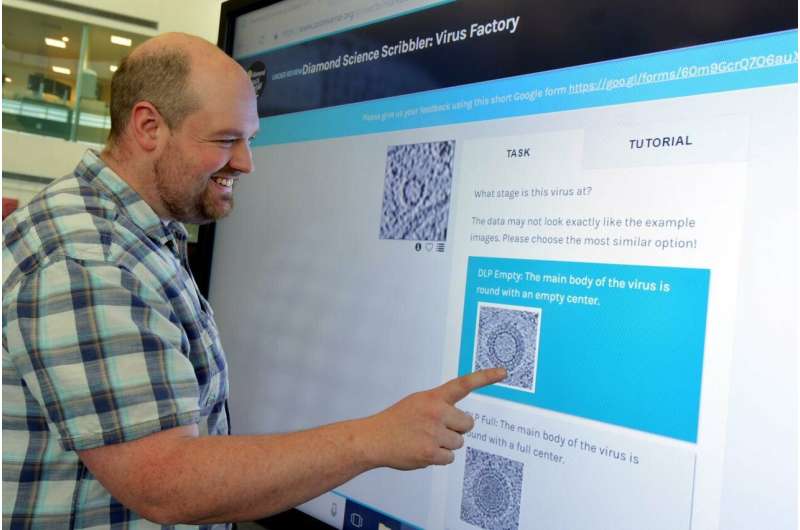Spare 10 minutes to make science leap forward

Today sees the launch of an innovative Citizen Science Project by Diamond Light Source, the UK's national synchrotron science facility.The project uses a crowdsourcing model to call on people of all ages around the world to help speed up the analysis of the terabytes of data that Diamond generates every day. The first task set for citizen scientists is to spend a few minutes looking at a series of screens to identify viruses. More tasks will be set for other targets over the next three years. This will help train Artificial Intelligence systems (AI) and develop new ways of segmenting data, with the aim to automate the data segmentation processes. Doing this will dramatically speed up scientists' ability to understand their research data in a matter of days rather than the current weeks, allowing for a faster path to understanding disease structures, and perhaps speeding up pathways to drug development.
Unveiled at the American Association for the Advancement of Science in Washington DC, The Diamond "Science Scribbler—Virus Project", is the first of its kind that members of the public can help with in such a big way. It is funded by the world's biggest biomedical charity, the Wellcome Trust and being developed in collaboration with Zooniverse, the renowned citizen science web platform.
Professor Dave Stuart FRS, MRC Professor of Structural Biology at the University of Oxford and Life Sciences Director at Diamond Light Source explains:
"The ultimate goal is to completely automate segmentation using advances in deep learning. Such methods require significant quantities of already segmented data to train the systems we use. To build segmented data for this development, Zooniverse will offer members of the public across the globe the chance to partake in segmenting datasets to help researchers. This project aims to address these issues by providing tools to help researchers label features of interest, and to gather the data that is produced by citizen scientists in a standardised way that can be used to automate the process in the future, thereby helping fasten the analysis process from weeks to days or less."
Diamond produces 500 terabytes of biological data a month, from high-resolution detailed atomic maps to low resolution data, which makes the current methodologies of data segmentation challenging. Data is often low contrast and blurred, and can be so large in size it becomes hugely labour-intensive to analyse.
Dave Stuart continues:
"What we are doing now is to use cryo-electron tomography to visualise virus particles from the reovirus family in very thin slices cut from frozen infected cells. Our aim is, ultimately, to understand the full life cycle, how the virus gets into the cell, replicates, assembles and finally leaves the cell. In the tomograms here we have taken a snapshot 12 hours after infection and are aiming to visualise intermediate steps in the assembly process which have not been visible before, and to then work out how virus assembly is organised in time and space within the cell."
Reoviruses belong to a large family of viruses that infect a wide range of animals and plants. Some members of the family cause widespread disease, notably Rotaviruses, which is responsible for serious gastroenteritis across the globe. In contrast, reoviruses themselves, whilst they pervasively infect humans, they do not typically produce symptoms. Indeed, they are being trialled as possible anti-cancer agents, since they specifically replicate in many cancer cells activated for division. They are therefore a good starting point to try to understand the life-cycle of this family of viruses.
Mark Basham, Project Coordinator at Diamond Light Source, says:
"We simply need as many people as possible to view images and locate what they recognise to be virus particles. This is based on real data and exciting work already underway at Diamond looking at the reovirus. This is screen time we can all advocate and we are not making too great a claim when we say it could benefit all of mankind in terms of accelerating scientists' analysis of their research."
Prof Chris Lintott, Zooniverse PI at the University of Oxford, further adds; "You don't need any specialised background, training, or expertise to participate in any of the Zooniverse projects. We make it easy for anyone interested to contribute to real academic research, on their own computer or through a mobile Application, at their own convenience. We hopeThe Diamond "Science Scribbler—Virus Project"will entice you to become a regular volunteer."
Project Coordinator Dr. Mark Basham concludes:
"Artificial Intelligence has begun to have a massive impact on the world in the last few years, from beating humans in games such as Go, to the amazing advances in self-driving cars. These dramatic developments have been aided by the availability of vast quantities of data with which AI systems can be trained with. Alongside these developments, 3-D imaging of frozen cells, for example, has also developed rapidly, but as yet, very little training data is available. Researchers spend much of their time manually processing their data and this is an area where AI could be heavily used. However, for, machine learning to be possible, we need human input to guide the process and this is where members of the public can make a huge difference to our work."
More information: Spare 10 minutes to help drive science forward, by trying out the project here:http://www.diamond.ac.uk/zooniverse
Provided by Diamond Light Source
















